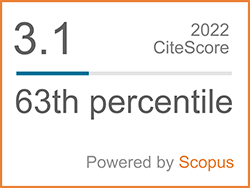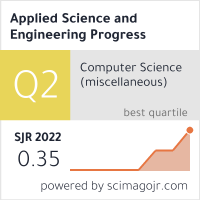Evaluation of Anti-Foodborne Bacterial Activity, Digestive Enzyme Secretion, and Antimicrobial Resistant Genes as Probiotic Strains Selection for Industrial Interest
Abstract
Keywords
[1] N. Suksaranludee, “Probiotics: market and opportunity for Thai entrepreneurs,” presented at the 18th NSTDA Annual Conference, Pathum Thani, Thailand, Mar. 28–31, 2023.
[2] Bangkok Bank, “Ready! “probiotics” Thai strains to reduce import costs prepare to export more than 13 countries around the world,” 2023. [Online]. Available: www.bangkokbanksme.com/ en/23-7focus-probiotic-thai-strain%0A%0A
[3] FAO, “Probiotics in animal nutrition-Production, impact and regulation,” FAO, Rome, Italy, 2016.
[4] N. Chaiyawan, P. Taveeteptaikul, B. Wannissorn, S. Ruengsomwong, P. Klungsupya, W. Buaban, and P. Itsaranuwat, “Characterization and probiotic properties of Bacillus strains,” Thai Journal of Veterinary Medicine, vol. 40, no. 2, pp. 207–214, 2010.
[5] K. Kongnum and T. Hongpattarakere, “Fish & shell fish immunology effect of Lactobacillus plantarum isolated from digestive tract of wild shrimp on growth and survival of white shrimp (Litopenaeus vannamei) challenged with Vibrio harveyi,” Fish and Shellfish Immunology, vol. 32, pp. 170–177, 2012.
[6] C. Kasornpikul and S. Chalorsuntisakul, “Efficacy of isolated probiotic bacteria from piglet nostrils in fattening pigs,” Silpakorn University Science and Technology, vol. 10, no. 3, pp. 15–19, 2016.
[7] FAO/WHO, “Guidelines for the evaluation of probiotics in food,” Ontario, London, 2002.
[8] Notification of the Ministry of Public Health, “Use of probiotic microorganisms in foods,” Government Gazette Thailand, Bangkok, Thailand, vol. 128, special part 86, Aug. 2011.
[9] S. Tejero-Sariñena, J. Barlow, A. Costabile, G. R. Gibson, and I. Rowland, “In vitro evaluation of the antimicrobial activity of a range of probiotics against pathogens: Evidence for the effects of organic acids,” Anaerobe, vol. 18, no. 5, pp. 530–538, 2012.
[10] H. R. Taheri, H. Moravej, F. Tabandeh, M. Zaghari, and M. Shivazad, “Screening of lactic acid bacteria toward their selection as a source of chicken probiotic,” Poultry Science, vol. 88, pp. 1586–1593, 2009.
[11] S. Chuob, A. Prommakool, C. Chumnanka, C. Tayuan, A. Sirijariyawat, K. Phattayakorn, and W. Savedboworn, “Antibiotic resistance of lactic acid bacteria isolated from Cambodian fish paste product,” Applied Science and Engineering Progress, vol. 15, no. 4, 2022, Art. no. 5581, doi: 10.14416/j.asep.2021.11.006.
[12] W. Savedboworn, W. Riansa-ngawong, W. Sinlapacharoen, S. Pajakang, B. Patcharajarukit, and S. Tipkanon, “Assessment of probiotic properties in lactic acid bacteria isolated from fermented vegetables,” KMUTNB International Journal of Applied Science and Technology, vol. 7, no. 4, pp. 53–65, 2014.
[13] A. A. Boricha, S. L. Shekh, S. P. Pithva, P. S. Ambalam, and B. R. Manuel Vyas, “In vitro evaluation of probiotic properties of Lactobacillus species of food and human origin,” LWT - Food Science and Technology, vol. 106, pp. 201–208, 2019.
[14] C. P. Champagne, N. J. Gardner, and D. Roy, “Challenges in the addition of probiotic cultures to foods,” Critical Reviews in Food Science and Nutrition, vol. 45. pp. 61–84, 2005.
[15] F. Baruzzi, L. Quintieri, M. Morea, and L. Caputo, “Antimicrobial compounds produced by Bacillus spp. and applications in food,” in Science Against Microbial Pathogens: Communicating Current Research and Technological Advances, vol. 2, A. Méndez-Vilas, Ed. Spain: Formatex, pp. 1102–1111, 2011.
[16] F. A. C. Martinez, E. M. Balciunas, A. Converti, P. D. Cotter, and R. P. De Souza Oliveira, “Bacteriocin production by Bifidobacterium spp. A review,” Biotechnology Advances, vol. 31, pp. 482–488, 2013.
[17] R. Georgieva, L. Yochevab, L. Tserovskab, G. Zhelezovab, N. Stefanovaa, A. Atanasovaa, A. Dangulevaa, G. Ivanovaa, N. Karapetkova, N. Rumyana, and E. Karaivanovaa, “Antimicrobial activity and antibiotic susceptibility of Lactobacillus and Bifidobacterium spp. intended for use as starter and probiotic cultures,” Biotechnology and Biotechnological Equipment, vol. 29, no. 1, pp. 84–91, 2015.
[18] H.-L. Alakomi, E. Skyttä, M. Saarela, T. Mattila- Sandholm, K. Latva-Kala, and I. M. Helander, “Lactic acid permeabilizes gram-negative bacteria by disrupting the outer membrane,” Applied and Environmental Microbiology, vol. 66, no. 5, pp. 2001–2005, 2000.
[19] R. W. Phelan, C. Clarke, J. P. Morrissey, A. D. W. Dobson, F. O’Gara, and T. M. Barbosa, “Tetracycline resistance-encoding plasmid from Bacillus sp. strain #24, isolated from the marine sponge Haliclona simulans,” Applied and Environmental Microbiology, vol. 77, no. 1, pp. 327– 329, 2011.
[20] S. C. R. Thumu and P. M. Halami, “Presence of erythromycin and tetracycline resistance genes in lactic acid bacteria from fermented foods of Indian origin,” Antonie van Leeuwenhoek, International Journal of General and Molecular Microbiology, vol. 102, no. 4, pp. 541–551, 2012.
[21] T. Li, D. Teng, R. Mao, Y. Hao, X. Wang, and J. Wang, “A critical review of antibiotic resistance in probiotic bacteria,” Food Research International, vol. 136, Oct. 2020, Art. no. 109571, doi: 10.1016/j.foodres.2020.109571.
[22] L. Z. Jin, Y. W. Ho, N. Abdullah, and S. Jalaludin, “Digestive and bacterial enzyme activities in broilers fed diets supplemented with Lactobacillus cultures,” Poultry Science, vol. 79, no. 6, pp. 886–891, 2000.
[23] H. Hmani, L. Daoud, M. Jlidi, K. Jalleli, M. B. Ali, A. H. Brahim, M. Bargui, A. Dammak, and M. B. Ali, “A Bacillus subtilis strain as probiotic in poultry: Selection based on in vitro functional properties and enzymatic potentialities,” Journal of Industrial Microbiology and Biotechnology, vol. 44, pp. 1157–1166, 2017.
[24] Notification of the Ministry of Agriculture and Cooperatives, “Substances added to animal feed, quantity of use, and conditions for prohibiting the production, import, or sale of animal feed,” Government Gazette Thailand, Bangkok, Thailand, vol. 133, Dec. 2016, special section 306.
[25] S. Hankla and P. Amornrattanapan, “Probiotic potential of Bifidobacterium animalis isolated from humans and animals,” Burapha Science, vol. 22, no. 2, pp. 317–334, 2017.
[26] S. A. Cuozzo, F. J. M. Sesma, A. A. P. de R. Holgado, and R. R. Raya, “Methods for the detection and concentration of bacteriocins produced by lactic acid bacteria,” in Food Microbiology Protocols. Methods in Biotechnology, vol. 14, J. F. T. Spencer and A. L. de Ragout Spencer, Eds. Totowa, NJ: Humana Press, pp. 141–146, 2001.
[27] S. Pholwat, J. Liu, M. Taniuchi, R. Chinli, T. Pongpan, I. Thaipisutikul, P. Ratanakorn, J. A. Platts-Mills, M. Fleece, S. Stroup, J. Gratz, E. Mduma, B. Mujaga, T. Walongo, R. Nshama, C. Kimathi, S. Foongladda, and E. R. Houpt, “Genotypic antimicrobial resistance assays for use on E. coli isolates and stool specimens,” PLoS One, vol. 14, no. 5, May 2019, Art. no. e0216747, doi: 10.1371/journal.pone.0216747.
[28] M. Z. Nora Azirah, I. Marini, K. Murni, S. A. Harmin, and Y. M. Ina-Salwany, “Extracellular enzyme production of probiotic Bacillus JAQ04 and Micrococcus JAQ07 isolated from tiger grouper (Epinephelus fuscoguttatus),” International Journal of Chemical, Environmental & Biological Sciences, vol. 4, no. 1, pp. 57–60, 2016.
[29] E. Haba, O. Bresco, C. Ferrer, A. Marqués, M. Busquets, and A. Manresa, “Isolation of lipase-secreting bacteria by deploying used frying oil as selective substrate,” Enzyme and Microbial Technology, vol. 26, no. 1, pp. 40–44, 2000.
[30] R. M. Teather and P. J. Wood, “Use of Congo red-polysaccharide interactions in enumeration and characterization of cellulolytic bacteria from the bovine rumen,” Applied and Environmental Microbiology, vol. 43, no. 4, pp. 777–780, 1982.
[31] B. Yu, J. R. Liu, F. S. Hsiao, and P. W. S. Chiou, “Evaluation of Lactobacillus reuteri Pg4 strain expressing heterologous β-glucanase as a probiotic in poultry diets based on barley,” Animal Feed Science and Technology, vol. 141, pp. 82–91, 2008.
[32] A. K. Samanta, A. P. Kolte, S. Senani, M. Sridhar, and N. Jayapal, “A simple and efficient diffusion technique for assay of endo B-1,4-xylanase activity,” Brazilian Journal of Microbiology, vol. 42, no. 4, pp. 1349–1353, 2011.
[33] A. M. A. Maitig, M. A. M. Alhoot, and K. Tiwari, “Isolation and screening of extracellular protease enzyme from fungal isolates of soil,” Journal of Pure and Applied Microbiology, vol. 12, no. 4, pp. 2059–2067, 2018.
[34] C. Park, S. B. Kim, S. H. Choi, and S. Kim, “Comparison of 16S rRNA gene based microbial profiling using five next-generation sequencers and various primers,” Frontiers in Microbiology, vol. 12, pp. 1–15, Oct. 2021, Art. no. 715500, doi: 10.3389/fmicb.2021.715500.
[35] The National Center for Biotechnology Information. “GenBank Overview 2020,” 2020. [Online]. Available: https://www.ncbi.nlm.nih.gov/genbank
[36] The European Molecular Biology Laboratory. “European Nucleotide Archive,” 2020. [Online]. Available: http://www.ebi.ac.uk/ena
[37] V. Klose, K. Bayer, R. Bruckbeck, G. Schatzmayr, and A. P. Loibner, “In vitro antagonistic activities of animal intestinal strains against swine-associated pathogens,” Veterinary Microbiology, vol. 144, pp. 515–521, 2010.
[38] L. Ruiz-Rodríguez, J. Bleckwedel, M. E. Ortiz, M. Pescuma, and F. Mozzi, “Lactic Acid Bacteria,” in Industrial Biotechnology Microorganisms, vol. 1, C. Wittmann and J. C. Liao, Eds. Weinheim: Wiley-VCH Verlag GmbH & Co., pp. 395–451, 2016.
[39] C. B. Lewus and T. J. Montville, “Detection of bacteriocins produced by lactic acid bacteria,” Journal of Microbiological Methods, vol. 13, no. 2, pp. 145–150, 1991.
[40] N. T. Nguyen, M. Nakphaichit, S. Nitisinprasert, and S. Roytrakul, “Purification and characterization of a novel bacteriocin against vancomycin resistant enterococci produced by Enterococcus hirae HM02-04,” Applied Science and Engineering Progress, vol. 14, no. 2, pp. 259–270, 2020, doi: 10.14416/j.asep.2020.04.004.
[41] J. A. Reis, A. T. Paula, S. N. Casarotti, and A. L. B. Penna, “Lactic acid bacteria antimicrobial compounds: characteristics and applications,” Food Engineering Reviews, vol. 4, no. 2, pp. 124–140, 2012.
[42] J. M. Munita and C. A. Arias, “Mechanisms of antibiotic resistance,” Microbiology Spectrum, vol. 4, no. 2, pp. 1–24, Apr. 2016, doi: 10.1128/microbiolspec.VMBF-0016-2015.
[43] D. Girlich, L. Poirel, A. Carattoli, I. Kempf, M.-F. Lartigue, A. Bertini, and P. Nordmann, “Extended-spectrum β-lactamase CTX-M-1 in Escherichia coli isolates from healthy poultry in France,” Applied and Environmental Microbiology, vol. 73, no. 14, pp. 4681–4685, 2007.
[44] Y. Chander, S. R. Oliveira, and S. M. Goyal, “Identification of the tet(B) resistance gene in Streptococcus suis,” The Veterinary Journal, vol. 189, pp. 359–360, 2011.
[45] M. Saki, A. Farajzadeh Sheikh, S. Seyed‑Mohammadi, A. Zadegan Dezfuli, M. Shahin, M. Tabasi, H. Veisi, R. Keshavarzi, and P. Khani, “Occurrence of plasmid-mediated quinolone resistance genes in Pseudomonas aeruginosa strains isolated from clinical specimens in Southwest Iran: A multicentral study,” Scientific Reports, vol. 12, no. 1, 2296, Feb. 2022, doi: 10.1038/s41598- 022-06128-4.
[46] F. D. Salah, S. T. Soubeiga, A. K. Ouattara, A. Y. Sadji, A. Metuor-Dabire, D. Obiri-Yeboah, A. Banla-Kere, S. Karou, and J. Simpore, “Distribution of quinolone resistance gene (qnr) in ESBL-producing Escherichia coli and Klebsiella spp. in Lomé , Togo,” Antimicrobial Resistance & Infection Control, vol. 8, no. 104, Jun. 2019, doi: 10.1186/s13756-019-0552-0.
[47] T. Padmavathi, R. Bhargavi, P. R. Priyanka, N. R. Niranjan, and P. V. Pavitra, “Screening of potential probiotic lactic acid bacteria and production of amylase and its partial purification,” Journal of Genetic Engineering and Biotechnology, vol. 16, no. 2, pp. 357–362, 2018.
[48] D. J. Das, A. Shankar, J. B. Johnson, and S. Thomas, “Critical insights into antibiotic resistance transferability in probiotic Lactobacillus,” Nutrition, vol. 69, Jan. 2020, Art. no. 110567, doi: 10.1016/j.nut.2019.110567.
[49] M. Sharma, A. Wasan, and R. K. Sharma, “Recent developments in probiotics: An emphasis on Bifidobacterium,” Food Bioscience, vol. 41, Jun. 2021, Art. no. 100993, doi: 10.1016/j. fbio.2021.100993.
[50] J. R. Whitaker, “Proteolytic enzyme,” in Handbook of Food Enzymology, J. R. Whitaker, A. G. J. Voragen, and D. W. S. Wong, Eds. New York: Marcel Dekker, Inc., pp. 993–1018, 2003.
[51] S. Boonvisut, Nutritive Values of Thai Foods. Nonthaburi: Nutrition division, Department of health, Ministry of Public Health, Thailand, pp. 17–60, 2001.
[52] F. Yildiz, “Amino acids, oligopeptides, polypeptides, and proteins,” in Advances in Food Biochemistry, F. Yildiz, Ed. Boca Raton: CRC Press, pp. 51–100, 2010.
[53] S. El-Ghaish, M. Dalgalarrondo, Y. Choiset, M. Sitohy, I. Ivanova, T. Haertle´, and J. M. Chobert, “Characterization of a new isolate of Lactobacillus fermentum IFO 3956 from Egyptian Ras cheese with proteolytic activity,” European Food Research and Technology, vol. 230, pp. 635–643, 2010.
[54] Y. H. Lim, H. L. Foo, T. C. Loh, R. Mohamad, and N. Abdullah, “Comparative studies of versatile extracellular proteolytic activities of lactic acid bacteria and their potential for extracellular amino acid productions as feed supplements,” Journal of Animal Science and Biotechnology, vol. 10, no. 15, pp. 1–13, 2019.
[55] A. Caminero, M. Guzman, J. Libertucci, and A. E. Lomax, “The emerging roles of bacterial proteases in intestinal diseases,” Gut Microbes, vol. 15, no. 1, pp. 1–21, 2023.
[56] D. Bharathi and G. Rajalakshmi, “Microbial lipases: An overview of screening, production and purification,” Biocatalysis and Agricultural Biotechnology, vol. 22, Nov. 2019, Art. no. 101368, doi: 10.1016/j.bcab.2019.101368.
[57] C. A. Salgado, C. I. A. dos Santos, and M. C. D. Vanetti, “Microbial lipases: Propitious biocatalysts for the food industry,” Food Bioscience, vol. 45, Feb. 2022, Art. no. 101509, doi: 10.1016/j.fbio.2021.101509.
[58] F. T. Orthoefer, “Rice bran oil,” in Bailey’s Industrial Oil and Fat Products, F. Shahidi, Ed. Hoboken, NJ: John Wiley & Sons, Ltd., pp. 469–485, 2005.
[59] I. S. Arvanitoyannis, T. H. Varzakas, S. Kiokias, and A. E. Labropoulos, “Lipids, fats, and oils,” in Advances in Food Biochemistry, F. Yildiz, Ed. Boca Raton: CRC Press, pp. 131–201, 2010.
[60] F. A. Manthey and Y. Xu, “Glycobiology of foods: Food carbohydrates—occurrence, production, food uses, and healthful properties,” in Advances in Food Biochemistry, F. Yildiz, Ed. Boca Raton: CRC Press, pp. 23–49, 2010.
[61] S. Tavallaie, M. Khomeiri, M. Mousivand, Y. Maghsoudlou, and M. Hashemi, “Starches from different sources hydrolysis using a new thermo-tolerant amylase complex produced by Bacillus subtilis T41a: Characterization and efficiency evaluation,” LWT - Food Science and Technology, vol. 112, Sep. 2019, Art. no. 108218, doi: 10.1016/j.lwt.2019.05.116.
[62] M. I. R. Khan, T. G. Choudhury, D. Kamilya, S. J. Monsang, and J. Parhi, “Characterization of Bacillus spp. isolated from intestine of Labeo rohita—towards identifying novel probiotics for aquaculture,” Aquaculture Research, vol. 52, no. 2, pp. 822–830, 2020.
[63] M. M. A. El-Sawah, A. A. Sherief, and S. M. Bayoumy, “Enzymatic properties of lipase and characteristics production by Lactobacillus delbrueckii subsp, bulgaricus,” Antonie Van Leeuwenhoek, vol. 67, pp. 357–362, 1995.
[64] The National Center for Biotechnology Information, “Basic local alignment search tool,” 2023. [Online]. Available: https://blast.ncbi.nlm. nih.gov/Blast.cgi
[65] S. Choudhuri, Bioinformatics for Beginners. San Deigo: CA: Academic Press, pp. 209–218, 2014.
[66] C. Hoppe, C. N. Larsen, R. Fondén, U. Svensson, A. Ouwehand, S. Lahtinenand, M. Kiwaki, K. Nomoto, K. Kimura, D. Eskesen, M. Saxelin, K. Kajander, G. Reid, A. W. Bruce, P. Nurminen, R. Korpela, H. Tsuji, J.-Z. Xiao, and S. Salminen, “Commercially available human probiotic microorganisms,” in Handbook of Probiotics and Prebiotics, Y. K. Lee and S. Salminen, Eds. New Jersey: John Wiley & Sons, Inc., pp. 441–532, 2008.
[67] E. M. Quigley, “Bifidobacterium animalis spp. lactis,” in The Microbiota in Gastrointestinal Pathophysiology: Implications for Human Health, Prebiotics, Probiotics, and Dysbiosis, M. H. Floch, Y. Ringel, and W. A. Walker, Eds. London: Academic Press: Elsevier Inc., pp. 127– 130, 2017.
[68] AAFCO, “2018 AAFCO Midyear Meeting Agenda Book,” Hyatt Regency Garden Grove, CA (Anaheim), Jan. 2018.
DOI: 10.14416/j.asep.2023.12.003
Refbacks
- There are currently no refbacks.






.png)



